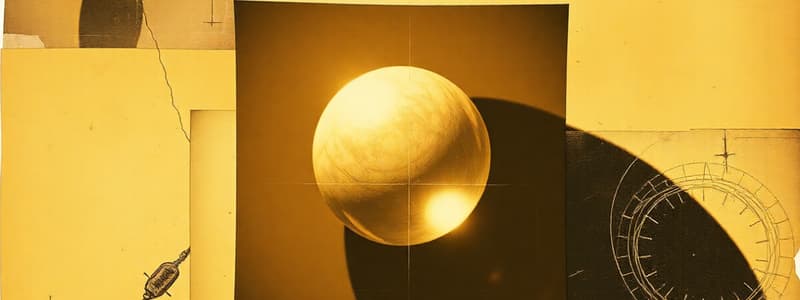Podcast
Questions and Answers
What happens to light when it encounters the surface of a different medium?
What happens to light when it encounters the surface of a different medium?
- It is always absorbed.
- It can only be reflected.
- It may be reflected, absorbed, or transmitted. (correct)
- It disappears immediately.
If a light source illuminates a black card surface, what is the primary outcome?
If a light source illuminates a black card surface, what is the primary outcome?
- Most light is reflected off the card.
- Most light is absorbed by the card. (correct)
- Most light is refracted within the card.
- Most light is transmitted through the card.
Which material would most likely transmit most of the light when illuminated?
Which material would most likely transmit most of the light when illuminated?
- Opaque plastic
- Clear glass (correct)
- Black card
- Mirror
What effect occurs when light strikes a mirror?
What effect occurs when light strikes a mirror?
What unique phenomenon can occur at surfaces with fine structures?
What unique phenomenon can occur at surfaces with fine structures?
Flashcards
Light Transmission
Light Transmission
Light passing through a new medium after encountering a surface.
Light Reflection
Light Reflection
Light bouncing back from a surface.
Light Absorption
Light Absorption
Light energy being converted to another form of energy or a different form (e.g., heat).
Optical Surface
Optical Surface
Signup and view all the flashcards
Light's Behavior at a Surface
Light's Behavior at a Surface
Signup and view all the flashcards
Study Notes
Light Interactions at Surfaces
- Light from an isotropic homogeneous source travels in straight rays and expanding wavefronts.
- Light encountering an optical surface undergoes one or more of these three effects: reflection, absorption, and transmission.
- Reflection: Light bounces back from the surface. The amount reflected depends on the materials.
- Absorption: Light is converted into other forms of energy or absorbed (lost). The amount absorbed depends on the materials.
- Transmission: Light passes through the surface into the new medium. The amount transmitted depends on the materials.
Examples of Effects
- A black screen absorbs most light.
- A white screen reflects most light.
- A mirror reflects light in a specific way (details in Section 1.7).
- Clear glass transmits most light.
Combined Effects
- Reflection, absorption, and transmission always occur at an optical surface.
- Sometimes one effect dominates, masking the others.
- More unusual effects such as light absorption and re-emission at different wavelengths, can also occur.
- Fine surface structures can lead to additional effects.
Studying That Suits You
Use AI to generate personalized quizzes and flashcards to suit your learning preferences.




